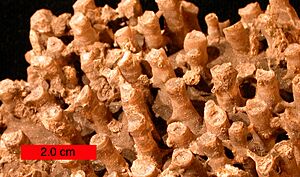Syringopora facts for kids
Quick facts for kids SyringoporaTemporal range: Ordovician-Permian
|
|
|---|---|
 |
|
| Syringopora; Boone Limestone (Lower Carboniferous) near Hiwasse, Arkansas. | |
| Scientific classification |
|
| Unrecognized taxon (fix): | Syringopora |
Syringopora was an ancient type of coral that lived a very long time ago. It's now extinct, meaning it no longer exists on Earth. Imagine a coral that looked like a bunch of small tubes packed together! That's a bit like Syringopora. Scientists find its fossils in rocks, which helps us learn about life millions of years ago.
Contents
Discovering Syringopora: An Ancient Coral
What Was Syringopora?
Syringopora was a kind of tabulate coral. These corals are known for their unique tube-like shapes. They often grew in colonies, meaning many tiny coral animals lived together. Each animal, called a polyp, lived in its own small tube. These tubes were connected inside.
This type of coral is called "phaceloid." This means its tubes grew mostly parallel to each other. They were not tightly packed like some other corals. Instead, they formed a cluster of individual tubes.
When Did Syringopora Live?
Syringopora lived for a very long time in Earth's history. Its fossils have been found in rocks from the Ordovician period all the way to the Permian period. That's a huge span of time, covering hundreds of millions of years!
It was most common during three specific periods:
- The Silurian period
- The Devonian period
- The Carboniferous period
These periods were when Syringopora was most widespread across the ancient oceans.
Where Did Syringopora Live?
Like most corals, Syringopora lived in ancient oceans. It needed clear, warm, and shallow waters to grow well. These conditions are similar to where many corals live today.
Scientists have found Syringopora fossils in many places around the world. For example, some fossils have been discovered in:
- The Columbus Limestone in Ohio, USA
- The Spring Branch Member of the Lecompton Limestone in Kansas, USA
Finding these fossils helps scientists understand what the Earth's oceans were like millions of years ago. It also shows us where these ancient coral reefs once thrived.
How Do We Know About Syringopora?
We know about Syringopora because of its fossils. When a coral died, its hard skeleton could be covered by mud and sand. Over millions of years, this mud and sand turned into rock. The coral skeleton also turned into rock, preserving its shape.
Scientists, called paleontologists, study these fossils. They can learn about the coral's size, shape, and how it might have lived. Fossils are like clues from the past. They help us piece together the story of life on Earth long before humans existed.
Why Are Fossils Important?
Fossils like Syringopora are super important for several reasons:
- Learning About Extinction: They show us that many types of animals and plants have lived and then disappeared from Earth. This helps us understand extinction.
- Understanding Earth's History: Fossils help us know what the environment was like millions of years ago. For example, finding coral fossils in Ohio tells us that Ohio was once covered by a warm, shallow sea.
- Studying Evolution: By looking at fossils from different time periods, scientists can see how life forms changed and evolved over vast stretches of time.

